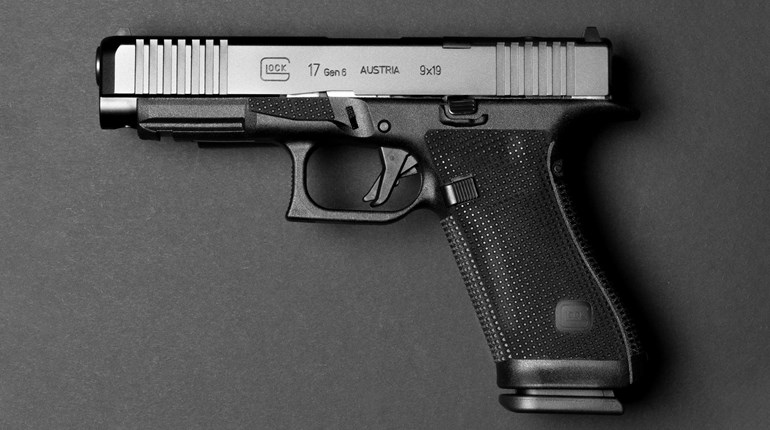
So, in my description of the origins of the 2,000-Round Challenge, I mentioned that the whole idea of the challenge was as follows: “Modern service pistols will generally have no difficulty making it through 2,000 rounds without any attention maintenance-wise, provided they’d initially been adequately lubed with a quality lubricant and are fed in-spec ammunition through good mags.”
This might make the subject of my first 2K Challenge write-up seem a little off-beat, since the Glock G43 is decidedly not a service pistol.
Rather, the Glock G43 is among the most popular of the burgeoning class of little single-stack (or quasi-single-stack) lightweight polymer 9 mm pistols. Once pretty much the sole province of Kahr Arms and its P9, the class is crowded with offerings ranging in price from budget Kel-Tecs and Rugers to Performance Center Smith & Wesson guns and the SIG Sauer P365.
Not really “pocket pistols," in the sense of the tiny .32 & .380 autos, these pistols definitely have more service-pistol-type pretensions. I’ve seen more than one Glock G42 in use in a firearm-training environment, and even saw a dude burn down some drills in an Ernest Langdon class at speeds that put him at or near the top.
This Glock G43 is identical in height and length to the Glock G26, a gun known for putting up with hard use just like its bigger siblings. Since it really differs from the G26 only in width, I wondered if it would be up to hard use the way 9 mm Glocks so legendarily are. There was only one way to find out, and that was to shoot it.
I purchased the pistol blind off-the-shelf of my local retailer, Indy Arms Company, and set to work building the round count right away, pausing only to add a couple of convenience accessories to the gun. Namely, I picked up a pair of spare mags, and replaced the pinkie rest on one magazine with a Pearce Grips Plus One magazine extension. Now I had three 6-round and one 7-round magazine, totaling 25 rounds, which would make keeping track of round count that much easier. Also, I replaced the factory slide stop with a TangoDown Vickers Tactical aftermarket unit.

After 400 malfunction-free rounds, I’d begun to draw a couple conclusions. First, I still really didn’t get along well with the cup-and-ball sight picture on the plastic front sights. Second, the skinny grip tended to punish errors in trigger finger placement a lot more harshly for me than the fatter grip of the G26. Lastly, this thing was really reliable! Among those first 400 rounds were 150 jacketed hollow points, of four different varieties, and I had yet to run across a load that caused function issues.
As a matter of fact, I didn’t experience my first malfunction until round No. 844 when, while experimenting with ever-higher grips trying to push more speed from the little gun, I managed to get a thumb atop the slide stop and prevent the slide locking back on an empty magazine. That being a user-induced malfunction, I was not inclined to charge it to the gun.
At the 1,100-round mark, the gun was still running without any malfunctions, but I couldn’t take the plastic factory sights and their funky “dot-in-a-box” sight picture anymore. It was at that point that I replaced them with a set of green AmeriGlo TCAP sights. After about 100 rounds re-acclimating to the Ameriglo sight picture, I was really beginning to get attached to the little blaster.
As the round count rolled to 1,350, I took the G43 to the range for some chronograph testing with some common self-defense loads (Hornady 115-grain Critical Defense, Federal Premium 124-grain HST, and Winchester 147-grain “Defend”) and a Gen 2 Glock G17 to use as a velocity benchmark. While the shorter barrel gave up between 60 and 100 fps to the full-size gun, the numbers were still close to the ones on the box flaps.
By round 1,600, there had not been any more stoppages. A couple of magazines had started to get little burrs on the plastic right in the top front, where the plastic covering the mag body would try to delaminate away from the metal mag tube underneath if a missed insertion had caused the mag to catch on the well. I solved that by filing the burrs off with the file of the Leatherman Micra on my keychain, and leaving a slight bevel there.
It was also at that point that I ordered and installed an Overwatch Precision TAC trigger. I had 400 rounds left to go, and I wanted to see if it would do two things: Be less irritating to my trigger finger than the factory serrated trigger and provide better feedback regarding trigger-finger placement, and thus help when trying to shoot faster. It did seem to help in the second regard, and it definitely did in the first.
The only other event of note was on round number 1,936 when I managed to choke my grip up high enough to cause the slide stop to engage while there were still rounds in the chamber.
When all the rounds were tallied, the count was 1,800 rounds of FMJ and 200 assorted JHP, and only two malfunctions, both of which were induced by my thumb contacting the slide stop while shooting with an exaggeratedly high grip.
I was satisfied enough with the Glock G43 that I contacted Dark Star Gear for a Hitchhiker AIWB holster. To this day, I use the G43 as my concealed-carry pistol for those days when I need to be extra careful with concealment.






































